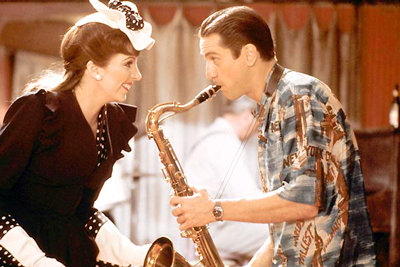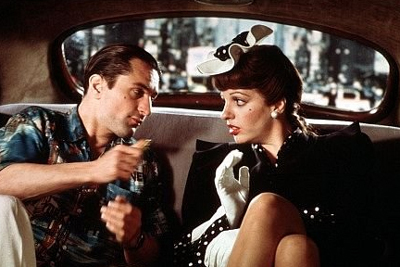
 |
|
|
|
I can see Martin Scorsese standing on the little stylized set for his Alice Doesn't Live Here Anymore movie, admiring the way stage illusion a la his screen hero Michael Powell had made the little flashback with Ellen Burstyn's child character come alive. We can hear him thinking: "Hmm, wouldn't it be nice to film this way for an entire picture, just like the old days?" Scorsese's follow-up to Taxi Driver was easily the most anticipated film of early 1977. I remember the crowds waiting in line at the Cinerama Dome, eager to find out what the director would do with Robert De Niro and Liza Minnelli in a glitzy Hollywood musical. As it turned out Scorsese did too little with too many ideas. The film is a mix of imagined showbiz bio, unpleasant characters and elaborate hommages to MGM musicals and the career of Judy Garland. It also includes some stylistic touches inspired by Scorsese's filmic hero, Michael Powell. And let's double down on the unpleasant characters. Everything looks terrific in New York, New York, especially now that we can see it in full detail in Blu-ray. The movie itself is oddly unsatisfying, starting with the basic concept. Audiences wanted to like Earl Mac Rauch's tale of twin musical careers but the film insists on wedding upbeat visuals to a story that's basically an exercise in unending frustration. 
New York, New York is similar to a standard musical bio from the 30s or 40s, the template for which might be Alexander's Ragtime Band. Two wide-eyed young talents start off in showbiz almost by accident, find success and fall in love. Fate and careers pull them apart yet they're somehow reunited in a kitschy musical climax. This sure-fire formula worked more often than it should have because it depended not on profound storytelling but on the personalities of talented stars. Lone wolf sax player Jimmy Doyle and spirited USO singer Francine Evans "meet cute," if a little nervously. Despite being more than a little overbearing in his obnoxiousness, we like Jimmy Doyle. In a normal musical bio, Doyle would eventually mellow, find some decent values and become an okay guy. But this is the Scorsese universe and Doyle seems to have wandered in from Travis Bickle country. We Taxi Driver converts were dismayed when, at about the film's midpoint, we realized that the movie wasn't going to develop and the characters weren't going to grow. Jimmy Doyle starts as a selfish and egotistical talent who becomes abusive when Francine becomes more successful than he. His brand of progressive jazz sax isn't mainstream and Francine's singing is, so she becomes the enemy. I believe the characters and I know they're realistic, but applying them to such a stylized musical bio framework is a big drag. New York, New York is a stack of variable musical numbers held apart by reels of an unpleasant guy being rotten to a woman who stays at his side far beyond any reason. In his book Easy Riders, Raging Bulls author Peter Biskind gives plenty of reasons for Scorsese's failure to fashion a movie out of such promising elements: big stars, lots of attractive swing music and plenty of money for production. A reel was cut out for the first theatrical engagements, but the material later restored only slows down the dramatically dead middle and end sections of the film. We're way ahead of the characters and frankly bored by the lack of variety in the scenes. The story of why Jimmy Doyle stays a rotten heel holds no special charm, and the good acting of the supporting cast and Liza Minnelli - who carries what works almost singlehandedly - goes for naught. Scorsese gives the film a naturalistic, feel-bad ending that has no impact. The director's faith in improvisational magic is not always comfortable with stylistics borrowed from older movie genres. He'd opened Alice Doesn't Live Here Anymore with an effective evocation of its heroine's dreams as expressed in a takeoff on Gone With The Wind. Here in New York, New York he fills the screen with crowds celebrating V-J day and sweeps his camera up above ballrooms crammed with extras, yet neglects to supply the simple emotions needed to make such scenes work. Nobody praises the tinkertoy screenplays of musicals like Stormy Weather or The Gang's All Here, but the fact is that the corny backstage dramatics in those movies have a sincerity that Scorsese can't find. Marrying A Star is Born with Umberto D sounds like a good idea only to a pretentious film student. The crying shame here is that New York, New York does all the difficult things beautifully. The period atmosphere is helped by a color scheme that reminds of gaudy glorious Technicolor. The big band and jazz songs performed on stage and in dance halls are marvelous in style and execution; scenes like these often didn't come off back in the Golden Era. Liza Minnelli is equally solid in her acting as she is belting out tunes, with the effect that it feels like punishment to see her disappointed time again by the heel played by De Niro. Francine repeatedly wins jobs for Doyle by steering him away from his progressive sax riffs. Scorsese doesn't realize that the audience isn't going to understand why the club owners don't like Doyle's sound, especially when Doyle is willing to compromise his principles and play square backups for Francine's vocals. Also, when it comes to time to make Francine look like a star, Scorsese's only ploy is to create lousy competition for her in the person of Bernice Bennett (Mary Kay Place, being extremely cooperative), who can't carry a tune. A 'klunky' old musical bio would be more gracious than that. 
When the movie stretches to include MGM/Arthur Freed-style musical numbers, the production finally hits a wall. The big numbers don't pay off on the promise felt in the early singing scenes, even granting the power of the title tune. 1 The climactic show stopper would have twice the impact if we weren't already exhausted. Liza screams one number earlier on (But the World Goes 'Round) that does most of the damage. The one they excised for the main release was a Broadway Ballet-type piece about the career of a star from movie usher to top diva. It's done in the Gene Kelly - Vincente Minnelli style (more family homage, there) with a particularly ineffective aping of Minnelli's sense of color design. Lots of red and big camera moves can't hide the fact that the song is trite and the dancing uninspired. Like the rest of the movie, we feel very little while mentally ticking off the sources for individual shots, like the 'floating close-up' of Liza in triumph as the background zooms away: Singin' in the Rain, Kiss Me Kate, any others? Ace designer Boris Leven's work elsewhere in the picture is much more interesting, especially the minimalist marriage sequence filmed in front of painted forest backdrops. The sense of visual economy helps the emotion of the sequence ... or maybe it's just Robert De Niro acting like a decent fellow for twenty seconds ("I love you!") that makes the design look good. We want Scorsese's play with the classic stylistics he admires to work. Montages and hand-painted titles (some looking identical to work in The Red Shoes) may have made him happy, but throwing together a bunch of effects from favorite old movies no longer suffices. Is this Scorsese's Brian De Palma movie? Larry Kert, Broadway's original Tony in West Side Story, is in the formerly deleted musical number. Interesting under-seen actor Don Calfa can be glimpsed in only one shot as a musician sitting next to De Niro on the bandstand. New York, New York doesn't follow through on any of its smaller character roles, and our emotional investment in actors like Lionel Stander, Dick Miller and Georgie Auld is not repaid. MGM's Blu-ray of New York, New York looks fine in HD. The 1:66 image has the often-hazy look of the original film, and the added lines of resolution take away the fuzzy quality of older NTSC transfers. The improved contrast really flatters Laszlo Kovacs' lushly colored images, which to me have the quality not of old Technicolor, but old Kodachrome! The extras hail from the 2005 special edition and hold up very well. Scorsese appears on a candid and informative commentary with Carrie Rickey, and in a short introduction. A gallery of alternate and deleted scenes is present. The hour-long two-part docu The New York, New York Stories has plenty of good and thoughtful content but like most studio produced featurettes relies too much on feature clips. The same goes for an interview piece with Liza Minnelli, which would have been better if edited shorter. Finally, cinematographer Laszlo Kovacs contributes a scene-specific commentary with some good observations about the film's style choices. A trailer and teaser top off the extras.
On a scale of Excellent, Good, Fair, and Poor,
New York, New York Blu-ray rates:
Footnote:
1. The title tune would have made even a mediocre 'straight' musical version of the movie a success. I remember an editor friend playing me a bootleg cassette of Minnelli singing the song at least six months before the film came out. Musical fans behaved as if they were hoping the movie would reincarnate Judy Garland in the body of her own daughter.
Reviews on the Savant main site have additional credits information and are often updated and annotated with reader input and graphics. Also, don't forget the 2010 Savant Wish List. T'was Ever Thus.
Review Staff | About DVD Talk | Newsletter Subscribe | Join DVD Talk Forum |
| ||||||||||||||||||